Investigation of Dynamic Processes of Rolling Stock–Track Interaction: Experimental Realization
Abstract
:1. Introduction
2. Measurement Methods
- Method 1 involves experimentally determined tensile stress values on the lateral side of the rail base and the outer side of the rail head (three-point method) [69].
- Method 2 is based on the difference between the opposite bending moments emerging in the rail web under the action of lateral forces (Schlumpf method) [69].
3. Measurement Analysis Results
- (a)
- Modification of the alignment and profile of the track structure;
- (b)
- Presence of constructive works and stop-off or crossing points;
- (c)
- Characteristics of train traffic of the track section;
- (d)
- Rolling stock movement mode;
- (e)
- Track maintenance system;
- (f)
- Climatic conditions of the region.
4. Discussion, Conclusions, and Future Recommendations
- Any formed rolling stock in the loaded state is characterized by non-uniformity of the loading on the wheel, which leads to the non-uniform static character of the rolling stock (this aspect can be referred to as the rolling stock specifications). This characteristic of rolling stock is one of the causes of the random character of the values registered in the experiment.
- The sampling methodology for the analysis of parameters of the rolling stock impact requires an adjustment related to accounting for the position of the wheel pair relative to the track axis and grouping samples in a similar way by all parameters investigated in view of these adjustments. This expands the volume of information obtained with the dynamic processes and enables the assessment of both the ratio of forces during the analysis of wheel stability on the rail and the processes of the wheel and rails during their interaction, as well as the processes of deformation inside the elements for the purpose of prediction of implementation of the maintenance system. Moreover, this leads to greater efficiency in the use of the data pool obtained during the registration.
- For the assessment of aspects of functional safety of clamping performance in different states of the rail substructure (sleepers and ballast) during the vehicle–track interaction, rail warping in different planes should be taken into consideration.
- To obtain information on the running of the deformation processes during the experiment, the data registered by each sensor individually must be available.
- To assess the random scatter of the registered values, it is necessary to account for the geometric and physical–mechanical characteristics of the rail track structure.
- For greater efficiency in the application of laboratory tests to the prediction of object behavior under real operating conditions, it is necessary to account for the links neglected and considered during the laboratory tests.
- The simulation of real processes implies the provision of the complex system of amplitude and frequency relationships which may be recreated under laboratory conditions on the basis of knowledge of the physics of the process and taking into account the time component.
- It is necessary to determine the correlation of the requirements for elements and structures, for example, cramping points, applicable during laboratory tests with the requirements for elements and structures applicable to specific operating conditions. This would allow us to:
- Qualify the technical states of the rail track elements and structures in view of the functional safety requirements on the basis of risk assessment for different operating conditions;
- Optimize the maintenance system for rail track structures throughout the life cycle of operation, taking into account the probability of risks;
- Optimize the monitoring system for railway infrastructure in view of climatic, structural, and operational variations in the process of operation.
Author Contributions
Funding
Institutional Review Board Statement
Informed Consent Statement
Data Availability Statement
Conflicts of Interest
References
- Bouhlal, L.; Lamdouar, N.; Kassou, F. Experimental Measurement and Simulation of Railway Track Irregularities. Civ. Eng. J. 2022, 8, 2235–2242. [Google Scholar] [CrossRef]
- El Moueddeb, M.; Louf, F.; Boucard, P.-A.; Dadié, F.; Saussine, G.; Sorrentino, D. An Efficient Numerical Model to Predict the Mechanical Response of a Railway Track in the Low-Frequency Range. Vibration 2022, 5, 326–343. [Google Scholar] [CrossRef]
- Link, F.M.; Wigger, R.; Wahl, T.; Kuffa, M.; Wegener, K. Acoustic roughness measurement of railway tracks: Implementation of an optical measurement approach & possible improvements to the standard. Proc. Inst. Mech. Eng. Part F J. Rail Rapid Transit 2022, 236, 1210–1217. [Google Scholar] [CrossRef]
- Oliveira, R.H.; Loprencipe, G.; Filho, F.G.V.A.; Pissardini, R.S. Experimental investigation on the use of multiple very low-cost inertial-based devices for comfort assessment and rail track monitoring. Measurement 2023, 199, 111549. [Google Scholar] [CrossRef]
- Skrickij, V.; Šabanovic, E.; Shi, D.; Ricci, S.; Rizzetto, L.; Bureika, G. Visual Measurement System for Wheel–Rail Lateral Position Evaluation. Sensors 2021, 21, 1297. [Google Scholar] [CrossRef]
- Szmagliński, J.; Wilk, A.; Koc, W.; Karwowski, K.; Chrostowski, P.; Skibicki, J.; Grulkowski, S.; Judek, S.; Licow, R.; Makowska-Jarosik, K.; et al. Verification of Satellite Railway Track Position Measurements Making Use of Standard Co-Ordinate Determination Techniques. Remote Sens. 2022, 14, 1855. [Google Scholar] [CrossRef]
- Ižvolta, L.; Šmalo, M. Assessment of the Track Geometry Quality from the Aspect of Safe and Reliable Operation of the Railway Track. Procedia Eng. 2015, 111, 344–350. [Google Scholar] [CrossRef] [Green Version]
- Fu, L.; Zhou, S.; Guo, P.; Tian, Z.; Zheng, Y. Dynamic characteristics of multiscale longitudinal stress and particle rotation in ballast track under vertical cyclic loads. Acta Geotech. 2021, 16, 1527–1545. [Google Scholar] [CrossRef]
- Haigermoser, A.; Eickhoff, B.; Thomas, D.; Coudert, F.; Grabner, G.; Zacher, M.; Kraft, S.; Bezin, Y. Describing and assessing track geometry quality. Veh. Syst. Dyn. 2014, 52, 189–206. [Google Scholar] [CrossRef]
- Palo, M.; Galar, D.; Nordmark, T.; Asplund, M.; Larsson, D. Condition monitoring at the wheel/rail interface for decision-making support. Proc. Inst. Mech. Eng. Part F J. Rail Rapid Transit 2014, 228, 705–715. [Google Scholar] [CrossRef]
- Erhova, N.; Bondarenko, I.; Shibko, O.; Velmagina, N. Development of the procedure for verifying the feasibility of designing an active suspension system for transport carriages. East.-Eur. J. Enterp. Technol. 2018, 3, 53–63. [Google Scholar] [CrossRef]
- Chiou, S.-B.; Yen, J.-Y. Precise railway alignment measurements of the horizontal circular curves and the vertical parabolic curves using the chord method. Proc. Inst. Mech. Eng. Part F J. Rail Rapid Transit 2019, 233, 537–549. [Google Scholar] [CrossRef]
- Ren, X.; Wu, S.; Xing, H.; Fang, X.; Ao, N.; Zhu, T.; Li, Q.; Kang, G. Fracture mechanics based residual life prediction of railway heavy coupler with measured load spectrum. Int. J. Fract. 2022, 234, 313–327. [Google Scholar] [CrossRef]
- Ariaudo, C.; Kuka, N.; Verardi, R. Impact of track health on vehicle-track interaction loads. In Advances in Dynamics of Vehicles on Roads and Tracks; Springer International Publishing: Berlin/Heidelberg, Germany, 2020; pp. 762–768. [Google Scholar] [CrossRef]
- Bižić, M.B.; Petrović, D.Z.; Tomić, M.C.; Djinović, Z.V. Development of method for experimental determination of wheel–rail contact forces and contact point position by using instrumented wheelset. Meas. Sci. Technol. 2017, 28, 075902. [Google Scholar] [CrossRef]
- Dumitriu, M.; Fologea, D.; Cruceanu, I.C. Effects analysis of vertical track irregularities on bogie vibration—Method based on bogie modelling and wheelsets accelerations measurement. IOP Conf. Ser. Mater. Sci. Eng. 2021, 1018, 012001. [Google Scholar] [CrossRef]
- Yang, Y.; Liu, G.; Wang, X. Time–frequency characteristic analysis method for track geometry irregularities based on multivariate empirical mode decomposition and Hilbert spectral analysis. Veh. Syst. Dyn. 2021, 59, 719–742. [Google Scholar] [CrossRef]
- Matsuoka, K.; Kajihara, K.; Tanaka, H. Identification of Vibration Modes and Wave Propagation of Operational Rails by Multipoint Hammering and Reciprocity Theorem. Materials 2022, 15, 811. [Google Scholar] [CrossRef]
- Blanco, B.; Gil-Negrete, N.; Kari, L.; Alonso, A. On the correction of rail accelerations predicted by numerical track models based on Timoshenko beam theory. Veh. Syst. Dyn. 2022, 60, 1993–2017. [Google Scholar] [CrossRef]
- Zhou, W.; Abdulhakeem, S.; Fang, C.; Han, I.; Li, G.; Wu, Y.; Faisal, Y. A new wayside method for measuring and evaluating wheel-rail contact forces and positions. Measurement 2020, 166, 108244. [Google Scholar] [CrossRef]
- Bernal, E.; Spiryagin, M.; Vollebregt, E.; Oldknow, K.; Stichel, S.; Shrestha, S.; Ahmad, S.; Wu, Q.; Sun, Y.; Cole, C. Prediction of rail surface damage in locomotive traction operations using laboratory-field measured and calibrated data. Eng. Fail. Anal. 2022, 135, 106165. [Google Scholar] [CrossRef]
- Pires, A.C.; Mendes, G.R.; Santos, G.F.M.; Dias, A.P.C.; Santos, A.A. Indirect identification of wheel rail contact forces of an instrumented heavy haul railway vehicle using machine learning. Mech. Syst. Signal Process. 2021, 160, 107806. [Google Scholar] [CrossRef]
- Gao, T.; Cong, J.; Wang, P.; Liu, J.; Wang, Y.; He, Q. Vertical track irregularity analysis of high-speed railways on simply-supported beam bridges based on the virtual track inspection method. Proc. Inst. Mech. Eng. Part F J. Rail Rapid Transit 2020, 235, 328–338. [Google Scholar] [CrossRef]
- Jauregui-Correa, J.C.; Morales-Velazquez, L.; Otremba, F.; Hurtado-Hurtado, G. Method for predicting dynamic loads for a health monitoring system for subway tracks. Front. Mech. Eng. 2022, 8, 858424. [Google Scholar] [CrossRef]
- Kouroussis, G.; Verlinden, O.; Conti, C. Free field vibrations caused by high-speed lines: Measurement and time domain simulation. Soil Dyn. Earthq. Eng. 2011, 31, 692–707. [Google Scholar] [CrossRef]
- Li, H.; Yang, W.G.; Liu, P.; Wang, M. Prediction method and experimental verification of vibration response caused by underground high-speed railways. J. Low Freq. Noise Vib. Act. Control. 2022, 42, 452–469. [Google Scholar] [CrossRef]
- Olivier, B.; Verlinden, O.; Kouroussis, G. Comparison of X–T and X–X co-simulation techniques applied on railway dynamics. Multibody Syst. Dyn. 2022, 55, 39–56. [Google Scholar] [CrossRef]
- Joh, S.-H.; Magno, K.; Hwang, S.H. Dynamic Deflection of a Railroad Sleeper from the Coupled Measurements of Acceleration and Strain. Sensors 2018, 18, 2182. [Google Scholar] [CrossRef] [Green Version]
- Tong, Y.; Liu, G.; Yousefian, K.; Jing, G. Track Vertical Stiffness—Value, Measurement Methods, Effective Parameters and Challenges: A review. Transp. Geotech. 2022, 37, 100833. [Google Scholar] [CrossRef]
- Varandas, J.N.; Paixão, A.; Fortunato, E.; Zuada Coelho, B.; Hölscher, P. Long-term deformation of railway tracks considering train-track interaction and non-linear resilient behaviour of aggregates—A 3D FEM implementation. Comput. Geotech. 2020, 126, 103712. [Google Scholar] [CrossRef]
- Bondarenko, I.; Severino, A.; Olayode, I.O.; Campisi, T.; Neduzha, L. Dynamic Sustainable Processes Simulation to Study Transport Object Efficiency. Infrastructures 2022, 7, 124. [Google Scholar] [CrossRef]
- Bondarenko, I.; Keršys, R.; Neduzha, L. Analysis of Problem Related to Experimental Data Processing in the Study of the Rolling Stock Influence on the Track. In Proceedings of the 26th International Conference Transport Means, Kaunas, Lithuania, 5–7 October 2022; pp. 663–668. [Google Scholar]
- Xu, P.; Liu, R.-K.; Wang, F.; Wang, F.-T.; Sun, Q.-X. Railroad Track Deterioration Characteristics Based Track Measurement Data Mining. Math. Probl. Eng. 2013, 1742, 970573. [Google Scholar] [CrossRef] [Green Version]
- Doi, H.; Hondo, T.; Nishiyama, Y.; Kuniyuki, S.; Tanaka, T. Stationary Test Method for Evaluating Wheel Unloading of Railway Vehicle on Twisted Track Simulated with Spacers between Wheel and Rail. Proc. Transp. Logist. Conf. 2020, 29, 3801. [Google Scholar] [CrossRef]
- Gruber, C.; Hammer, R.; Gänser, H.-P.; Künstner, D.; Eck, S. Use of Surface Acoustic Waves for Crack Detection on Railway Track Components—Laboratory Tests. Appl. Sci. 2022, 12, 6334. [Google Scholar] [CrossRef]
- Majstorović, I.; Ahac, M.; Madejski, J.; Lakušić, S. Influence of the Analytical Segment Length on the Tram Track Quality Assessment. Appl. Sci. 2022, 12, 10036. [Google Scholar] [CrossRef]
- Offenbacher, S.; Neuhold, J.; Veit, P.; Landgraf, M. Analyzing Major Track Quality Indices and Introducing a Universally Applicable TQI. Appl. Sci. 2020, 10, 8490. [Google Scholar] [CrossRef]
- Tešić, P.; Jovanović, S.; Dick, M. Analysis of vehicle/track interaction measurement data using the V/TI Monitor system. Gradevinar 2018, 70, 105–119. [Google Scholar] [CrossRef] [Green Version]
- Wei, D.; Wei, X.; Jia, L. Automatic Defect Description of Railway Track Line Image Based on Dense Captioning. Sensors 2022, 22, 6419. [Google Scholar] [CrossRef]
- Costa, J.N.; Ambrósio, J.; Andrade, A.R.; Frey, D. Safety assessment using computer experiments and surrogate modeling: Railway vehicle safety and track quality indices. Reliab. Eng. Syst. Saf. 2023, 229, 108856. [Google Scholar] [CrossRef]
- Barbosa, R.S. Evaluation of Railway Track Safety with a New Method for Track Quality Identification. J. Transp. Eng. 2016, 142, 04016053. [Google Scholar] [CrossRef]
- Guerrieri, M.; Parla, G.; Celauro, C. Digital image analysis technique for measuring railway track defects and ballast gradation. Measurement 2018, 113, 137–147. [Google Scholar] [CrossRef]
- Bondarenko, I. Development of algorithm for calculating dynamic processes of railroad track deformability work. East. -Eur. J. Enterp. Technol. 2016, 6/7, 28–36. [Google Scholar] [CrossRef] [Green Version]
- Bondarenko, I.; Keršys, R.; Neduzha, L. Studying of Dynamic Parameters Impulse Impact of the Vehicle Taking into Account the Track Stiffness Variations. In Proceedings of the 25th International Conference Transport Means, Kaunas, Lithuania, 6–8 October 2021; pp. 684–689. [Google Scholar]
- Bondarenko, I.; Keršys, A.; Neduzha, L. Assessment of the Railway Track Deformability Behaviour as the Parameter of Operational Availability Function. In Proceedings of the 25th International Conference Transport Means, Kaunas, Lithuania, 6–8 October 2021; pp. 644–648. [Google Scholar]
- Kalivoda, J.; Neduzha, L. Running Dynamics of Rail Vehicles. Energies 2022, 15, 5843. [Google Scholar] [CrossRef]
- Eklöf, K.; Nwichi-Holdsworth, A.; Eklöf, J. Novel Algorithm for Mutual Alignment of Railway Track Geometry Measurements. Transp. Res. Rec. 2021, 2675, 995–1004. [Google Scholar] [CrossRef]
- de Melo, A.L.O.; Kaewunruen, S.; Papaelias, M.; Li, T. A Novel Hybrid Method for Predicting Vertical Levelling Loss of Railway Track Geometry Under Dynamic Cyclic Loadings. Int. J. Struct. Stab. Dyn. 2022, 22, 2250162. [Google Scholar] [CrossRef]
- Wang, H.; Berkers, J.; Hurk, N.V.D.; Layegh, N.F. Study of loaded versus unloaded measurements in railway track inspection. Measurement 2020, 169, 108556. [Google Scholar] [CrossRef]
- Majstorović, I.; Ahac, M.; Lakušić, S. Track gauge monitoring scope optimization on small urban railway systems. In Proceedings of the 6th International Conference on Road and Rail Infrastructure CETRA 2020, Zagreb, Croatia, 20–21 May 2020. [Google Scholar] [CrossRef]
- Balouchi, F.; Bevan, A.; Formston, R. Development of railway track condition monitoring from multi-train in-service vehicles. Veh. Syst. Dyn. 2021, 59, 1397–1417. [Google Scholar] [CrossRef] [Green Version]
- Yang, Y.B.; Wang, Z.-L.; Shi, K.; Xu, H.; Wu, Y.T. State-of-the-Art of the Vehicle-Based Methods for Detecting the Various Properties of Highway Bridges and Railway Tracks. Int. J. Struct. Stab. Dyn. 2020, 20, 20410047. [Google Scholar] [CrossRef]
- Xiao, X.; Xu, X.; Shen, W. Identification of Frequencies and Track Irregularities of Railway Bridges Using Vehicle Responses: A Recursive Bayesian Kalman Filter Algorithm. J. Eng. Mech. 2022, 148, 04022051. [Google Scholar] [CrossRef]
- Vidovic, I.; Marschnig, S. Optical Fibres for Condition Monitoring of Railway Infrastructure—Encouraging Data Source or Errant Effort? Appl. Sci. 2020, 10, 6016. [Google Scholar] [CrossRef]
- Komorski, P.; Kominowski, J.; Motyl, M. A proposal for a mobile system of vehicle and rail track diagnostics. Transp. Probl. 2022, 17, 45–56. [Google Scholar] [CrossRef]
- Ma, S.; Gao, L.; Liu, X.; Lin, J. Deep Learning for Track Quality Evaluation of High-Speed Railway Based on Vehicle-Body Vibration Prediction. IEEE Access 2019, 7, 185099–185107. [Google Scholar] [CrossRef]
- Kulkarni, R.; Rosa, A.D.; Qazizadeh, A.; Berg, M.; Gialleonardo, E.D.; Facchinetti, A.; Bruni, S. Monitoring of Alignment Level (AL)and Cross Level (CL) track geometry irregularities from onboard vehicle dynamics measurements using probabilistic fault classifier. In Advances in Dynamics of Vehicles on Roads and Tracks II; Springer International Publishing: Berlin/Heidelberg, Germany, 2022; pp. 479–487. [Google Scholar] [CrossRef]
- Krishna, V.V.; Hossein-Nia, S.; Stichel, S. New methodology to estimate costs caused by rail wear and RCF depending on the type of running gear. In Advances in Dynamics of Vehicles on Roads and Tracks; Springer International Publishing: Cham, Switzerland, 2020; pp. 727–734. [Google Scholar] [CrossRef]
- Vlachospyros, G.; Iliopoulos, I.A.; Kritikakos, K.; Kaliorakis, N.; Fassois, S.D.; Sakellariou, J.S.; Deloukas, A.; Leoutsakos, G.; Giannakis, C.; Chronopoulos, E.; et al. The Maiandros system for random-vibration-based on-board railway vehicle and track monitoring. In ASME 2021 International Design Engineering Technical DETC2021-70166, V001T01A014; American Society of Mechanical Engineers: New York, NY, USA, 2021; pp. 1–10. [Google Scholar] [CrossRef]
- Licciardello, R.; Malavasi, G.; Tieri, A. Reference Values for Railway Sidings Track Geometry. Transp. Res. Procedia 2016, 14, 1996–2005. [Google Scholar] [CrossRef] [Green Version]
- Jönsson, J.; Khouy, I.A.; Lundberg, J.; Rantatalo, M.; Nissen, A. Measurement of vertical geometry variations in railway turnouts exposed to different operating conditions. Proc. Inst. Mech. Eng. Part F: J. Rail Rapid Transit 2016, 230, 486–501. [Google Scholar] [CrossRef]
- Morais, J.; Santos, C.; Morais, P.; Paixão, A.; Fortunato, E.; Asseiceiro, F.; Alvarenga, P.; Gomes, L. Continuous Monitoring and Evaluation of Railway Tracks: System Description and Assessment. Procedia Struct. Integr. 2019, 17, 448–455. [Google Scholar] [CrossRef]
- Berggren, E.G.; Nissen, A.; Paulsson, B.S. Track deflection and stiffness measurements from a track recording car. Proc. Inst. Mech. Eng. Part F J. Rail Rapid Transit 2014, 228, 570–580. [Google Scholar] [CrossRef]
- Zheng, S.; Zhong, Q.; Chen, X.; Peng, L.; Cui, G. The Rail Surface Defects Recognition via Operating Service Rail Vehicle Vibrations. Machines 2022, 10, 796. [Google Scholar] [CrossRef]
- de Souza, E.F.; Bittencourt, T.N.; Ribeiro, D.; Carvalho, H. Feasibility of Applying Mel-Frequency Cepstral Coefficients in a Drive-by Damage Detection Methodology for High-Speed Railway Bridges. Sustainability 2022, 14, 13290. [Google Scholar] [CrossRef]
- Lu, J.; Liang, B.; Lei, Q.; Li, X.; Liu, J.; Liu, J.; Xu, J.; Wang, W. SCueU-Net: Efficient Damage Detection Method for Railway Rail. IEEE Access 2020, 8, 125109–125120. [Google Scholar] [CrossRef]
- Firlik, B.; Tabaszewski, M. Monitoring of the technical condition of tracks based on machine learning. Proc. Inst. Mech. Eng. Part F: J. Rail Rapid Transit 2020, 234, 702–708. [Google Scholar] [CrossRef]
- Yuan, Z.; Zhu, S.; Chang, C.; Yuan, X.; Zhang, Q.; Zhai, W. An unsupervised method based on convolutional variational auto-encoder and anomaly detection algorithms for light rail squat localization. Constr. Build. Mater. 2021, 313, 125563. [Google Scholar] [CrossRef]
- DSTU 7571:2014; Railway Rolling Stock Permissible Exposure Norms to the Railway Track Width 1520 mm. Minekonomrozvitku: Kyiv, Ukraine, 2015.
- Li, Y.; Zhang, X.; Chen, Z.; Yang, Y.; Geng, C.; Zuo, M.J. Time-frequency ridge estimation: An effective tool for gear and bearing fault diagnosis at time-varying speeds. Mech. Syst. Signal Process. 2023, 189, 110108. [Google Scholar] [CrossRef]
- Farkas, A. Measurement of Railway Track Geometry: A State-of-the-Art Review. Period. Polytech. Transp. Eng. 2019, 48, 76–88. [Google Scholar] [CrossRef] [Green Version]
- Hur, H.M.; Shin, Y.J.; Seo, J.W.; Moon, K.H. Performance Evaluation of Track Curvature Sensor for Curvature Estimation in a Curved Section of Railway Tracks. Appl. Sci. 2022, 12, 5398. [Google Scholar] [CrossRef]
- Kulkarni, R.; Qazizadeh, A.; Berg, M.; Stichel, S. Fault Detection and Isolation (FDI) method for Vehicle Running Instability from Vehicle Dynamic Response using Machine Learning. In Proceedings of the 11th International Conference on Railway Bogies and Running Gears (BOGIE’19), Budapest, Hungary, 9–12 September 2019. [Google Scholar]
- Spiroiu, M.A.; Nicolescu, M. On the estimation of the reliability probabilistic model of railway wheelset. IOP Conf. Ser. Mater. Sci. Eng. 2019, 682, 012001. [Google Scholar] [CrossRef]
- Zhao, Q.; Wang, L.; Zhao, K.; Yang, H. Development of a Novel Piezoelectric Sensing System for Pavement Dynamic Load Identification. Sensors 2019, 19, 4668. [Google Scholar] [CrossRef] [PubMed] [Green Version]
- Wang, H.; Berkers, J.; Hurk, N.V.D. Study of an innovative method for track geometry inspection using a mobile inspection system. In Proceedings of the Transportation Research Board 99th Annual Meeting, Washington, DC, USA, 12–16 January 2020. [Google Scholar]
- Sowinski, B.; Stelmach, A.; Chudzikiewicz, A. Simulation Analysis of the Influence of Changes in Track Parameters on Running Safety of a Rail Vehicle. Energies 2021, 14, 5882. [Google Scholar] [CrossRef]
- Sun, J.; Meli, E.; Song, X.; Chi, M.; Jiao, W.; Jiang, Y. A novel measuring system for high-speed railway vehicles hunting monitoring able to predict wheelset motion and wheel/rail contact characteristics. Veh. Syst. Dyn. 2022, 1–23. [Google Scholar] [CrossRef]
- Du, C.; Dutta, S.A.; Kurup, P.; Yu, T.; Wang, X. A Review of Railway Infrastructure Monitoring using Fiber Optic Sensors. Sens. Actuators 2020, 303, 111728. [Google Scholar] [CrossRef]
- Gonzalo, A.P.; Horridge, R.; Steele, H.; Stewart, E.; Entezami, M. Review of Data Analytics for Condition Monitoring of Railway Track Geometry. IEEE Trans. Intell. Transp. Syst. 2022, 23, 22737–22754. [Google Scholar] [CrossRef]
- Magalhães, K.M.M.; Brasil, R.M.L.R.F.; Wahrhaftig, A.M.; Siqueira, G.H.; Bondarenko, I.; Neduzha, L. Influence of Atmospheric Humidity on the Critical Buckling Load of Reinforced Concrete Columns. Int. J. Struct. Stab. Dyn. 2022, 22, 2250011. [Google Scholar] [CrossRef]
- Louis, L.P.; Milne, D.R.M.; Thompson, D.; Powrie, W. Evaluating railway track support stiffness from trackside measurements in the absence of wheel load data. Can. Geotech. J. 2016, 53, 1156–1166. [Google Scholar] [CrossRef]
- Quirke, P.; Cantero, D.; OBrien, E.J.; Bowe, C. Drive-by detection of railway track stiffness variation using in-service vehicles. Proc. Inst. Mech. Eng. Part F J. Rail Rapid Transit 2016, 231, 498–514. [Google Scholar] [CrossRef] [Green Version]
- Do, N.T.; Gül, M.; Nafari, S.F. Continuous Evaluation of Track Modulus from a Moving Railcar Using ANN-Based Techniques. Vibration 2020, 3, 149–161. [Google Scholar] [CrossRef]
- Wang, P.; Wang, L.; Chen, R.; Xu, J.; Xu, J.; Gao, M. Overview and outlook on railway track stiffness measurement. J. Mod. Transp. 2016, 24, 89–102. [Google Scholar] [CrossRef] [Green Version]
- Lee, S.-J.; Ahn, D.; You, I.; Yoo, D.-Y.; Kang, Y.-S. Wireless cement-based sensor for self-monitoring of railway concrete infrastructures. Autom. Constr. 2020, 119, 103323. [Google Scholar] [CrossRef]
- Castillo-Mingorance, J.M.; Sol-Sánchez, M.; Moreno-Navarro, F.; Rubio-Gámez, M.C. A Critical Review of Sensors for the Continuous Monitoring of Smart and Sustainable Railway Infrastructures. Sustainability 2020, 12, 9428. [Google Scholar] [CrossRef]
- Ferreira, P.M.; Machado, M.A.; Carvalho, M.S.; Vidal, C. Embedded Sensors for Structural Health Monitoring: Methodologies and Applications Review. Sensors 2022, 22, 8320. [Google Scholar] [CrossRef]
- Gonzalo, A.P.; Entezami, M.; Roberts, C.; Weston, P.; Stewart, E.; Hayward, M.; Hsu, S.S. Railway track location estimation using onboard inertial sensors. Veh. Syst. Dyn. 2022, 60, 3631–3649. [Google Scholar] [CrossRef]
- Odziemczyk, W.; Woźniak, M. Analysis of railway track geometry measurement methods usability. Transp. Overv. -Prz. Komun. 2018, 8, 40–50. [Google Scholar] [CrossRef]
- Pas, J.; Rosinski, A.; Wetoszka, P.; Białek, K.; Klimczak, T.; Siergiejczyk, M. Assessment of the Impact of Emitted Radiated Interference Generated by a Selected Rail Traction Unit on the Operating Process of Trackside Video Monitoring Systems. Electronics 2022, 11, 2554. [Google Scholar] [CrossRef]
- Wang, P.; Wang, Y.; Tang, H.; Gao, M.; Chen, R.; Xum, J. Error Theory of Chord-based Measurement System regarding Track Geometry and Improvement by High Frequency Sampling. Measurement 2017, 115, 204–216. [Google Scholar] [CrossRef]
- Malekjafarian, A.; OBrien, E.; Quirke, P.; Bowe, C. Railway Track Monitoring Using Train Measurements: An Experimental Case Study. Appl. Sci. 2019, 9, 4859. [Google Scholar] [CrossRef] [Green Version]
- Sol-Sánchez, M.; Castillo-Mingorance, J.M.; Moreno-Navarro, F.; Mattinzioli, T.; Rubio-Gámez, M.C. Piezoelectric-sensored sustainable pads for smart railway traffic and track state monitoring: Full-scale laboratory tests. Constr. Build. Mater. 2021, 301, 124324. [Google Scholar] [CrossRef]
- Jiao, P.; Egbe, K.-J.I.; Xie, Y.; Nazar, A.M.; Alavi, A.H. Piezoelectric Sensing Techniques in Structural Health Monitoring: A State-of-the-Art Review. Sensors 2020, 20, 3730. [Google Scholar] [CrossRef] [PubMed]
- Zhang, S.L.; Koh, C.G.; Kuang, K.S.C. . Proposed rail pad sensor for wheel-rail contact force monitoring. Smart Mater. Struct. 2018, 27, 115041. [Google Scholar] [CrossRef]
- Li, P.; Lan, C.; Liu, Z.; Li, J.; Wu, W.; Wang, J.; Wang, X.; Qiu, J.; Liu, D. A bi-block sleeper dynamic strain monitoring method based on embedded FRP-OF sensor. Constr. Build. Mater. 2022, 330, 127271. [Google Scholar] [CrossRef]
- Pavković, D.; Cipek, M.; Kljaic, Z.; Mlinarić, T.J. A fuzzy logic-based classifier for railway track condition estimation and tractive effort conditioning using data from remote sensors. In Proceedings of the XXIV International Conference on Material Handling, Constructions and Logistics—MHCL ’22, Belgrade, Serbia, 21–23 September 2022. [Google Scholar]
- Noguchi, Y. Method for Measuring Wheel/Rail Contact Positions Using Strain Gauges. IEEJ Trans. Ind. Appl. 2021, 141, 241–248. [Google Scholar] [CrossRef]
- Bondarenko, I.; Campisi, T.; Tesoriere, G.; Neduzha, L. Using Detailing Concept to Assess Railway Functional Safety. Sustainability 2023, 15, 18. [Google Scholar] [CrossRef]

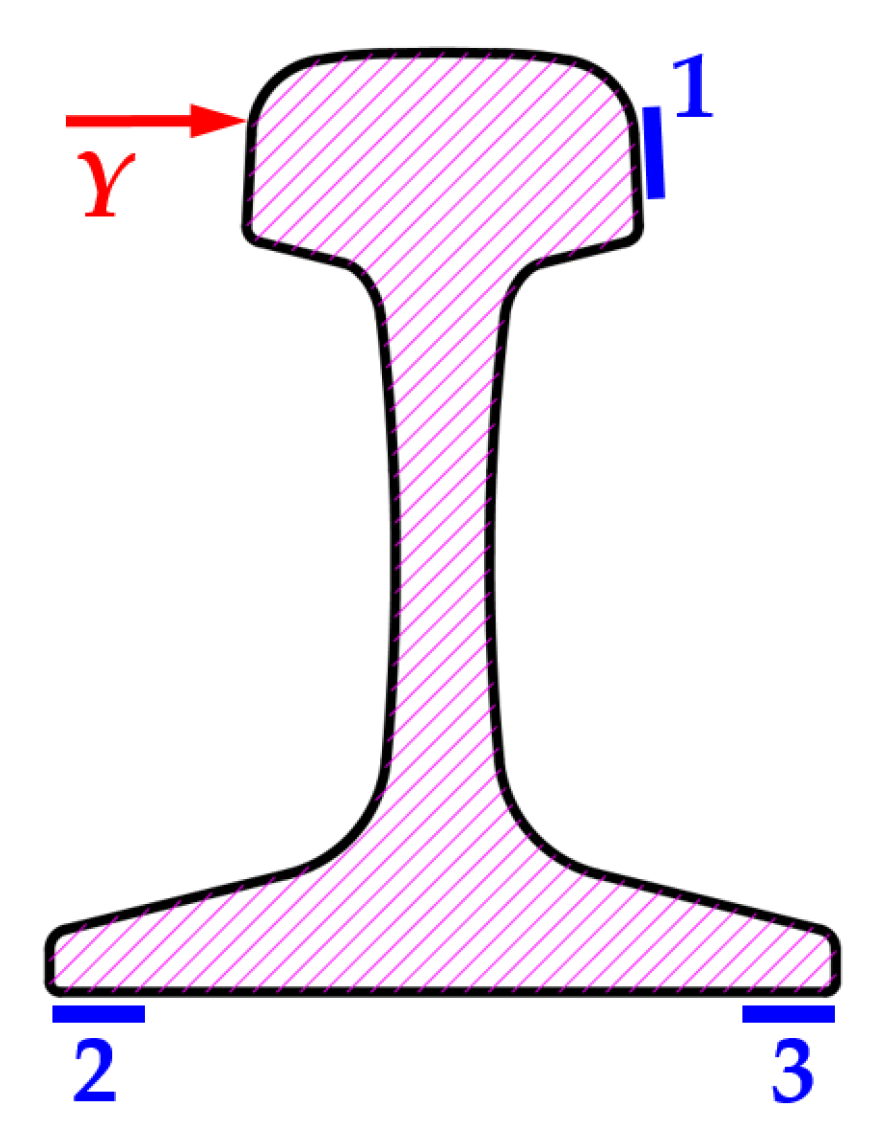
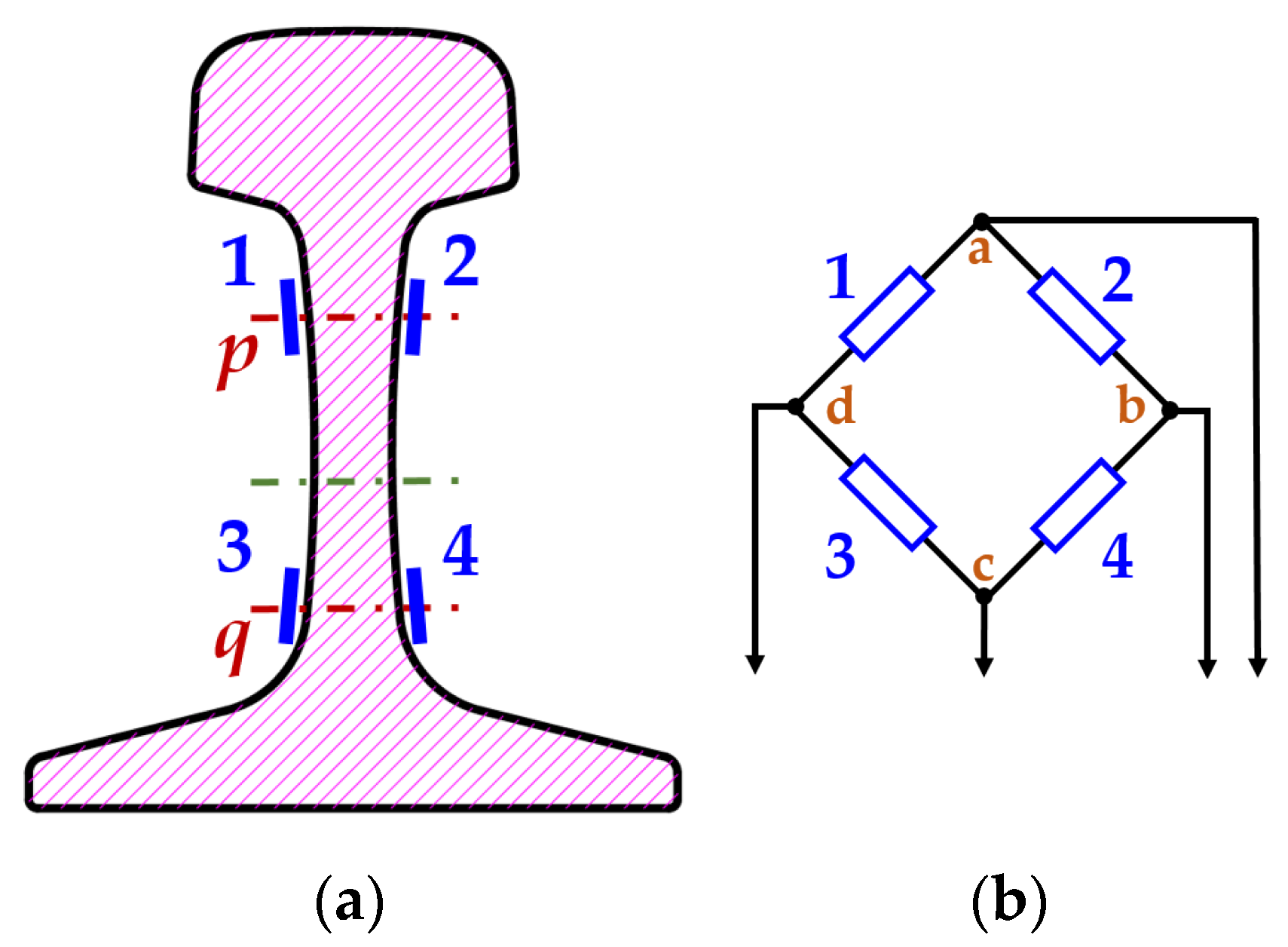
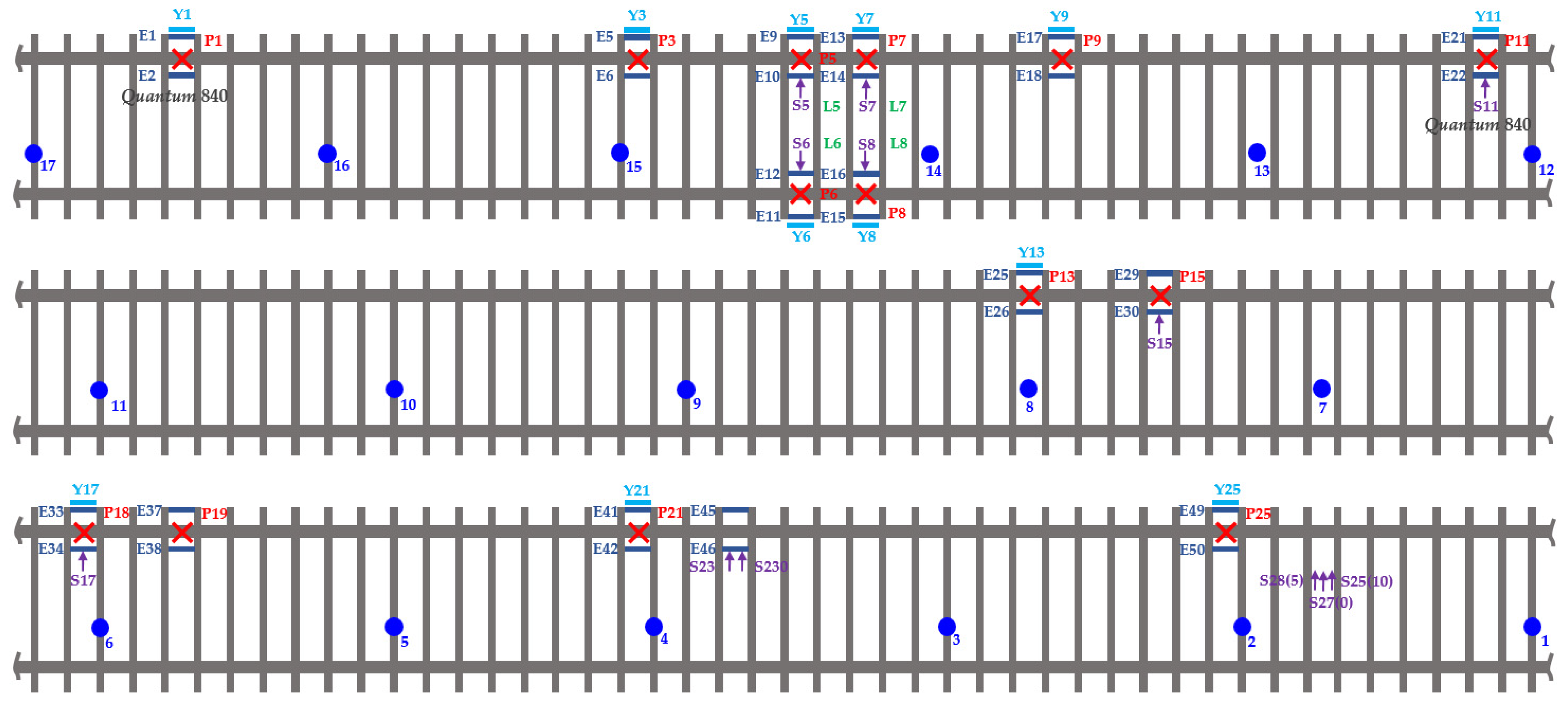
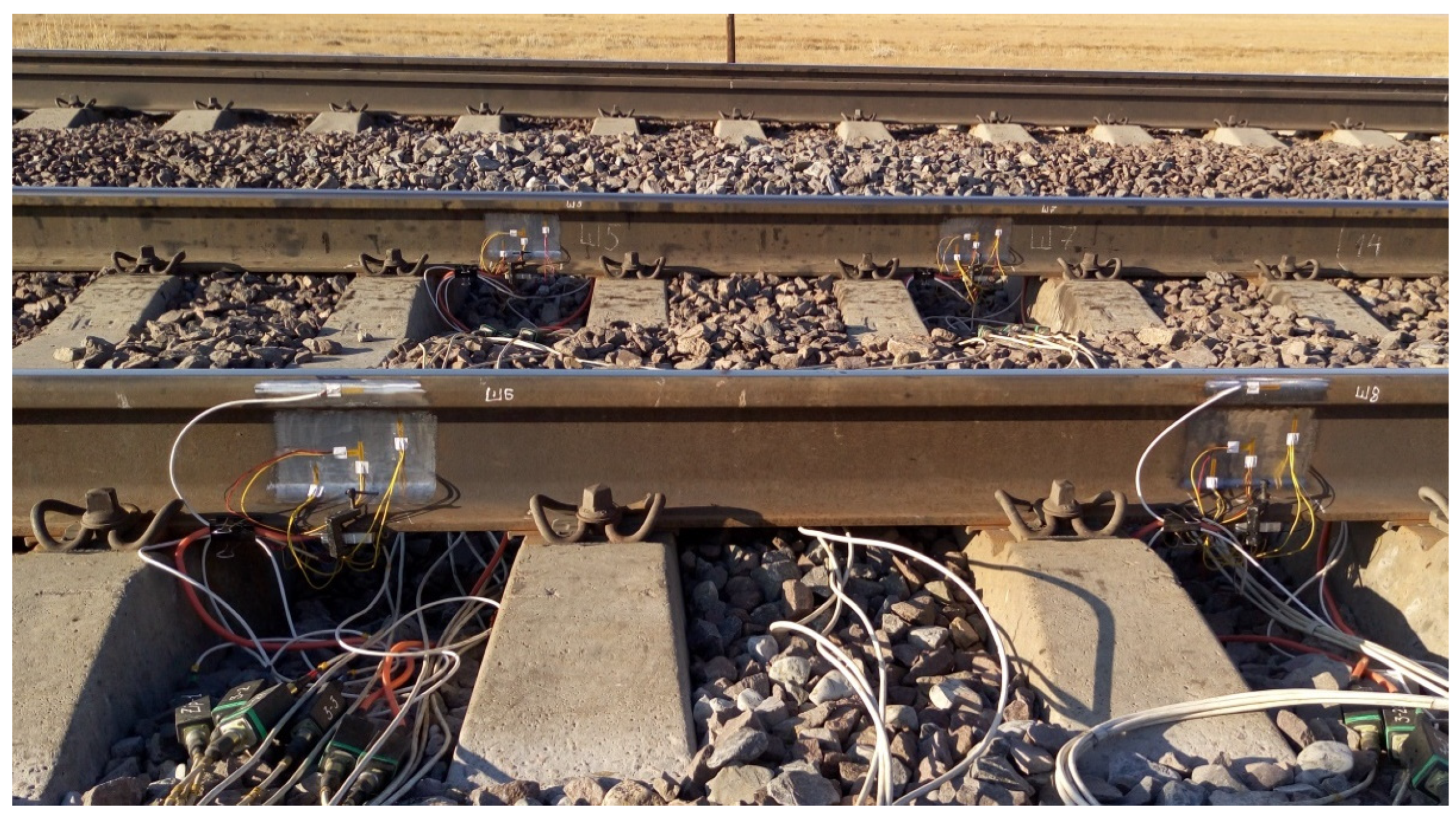
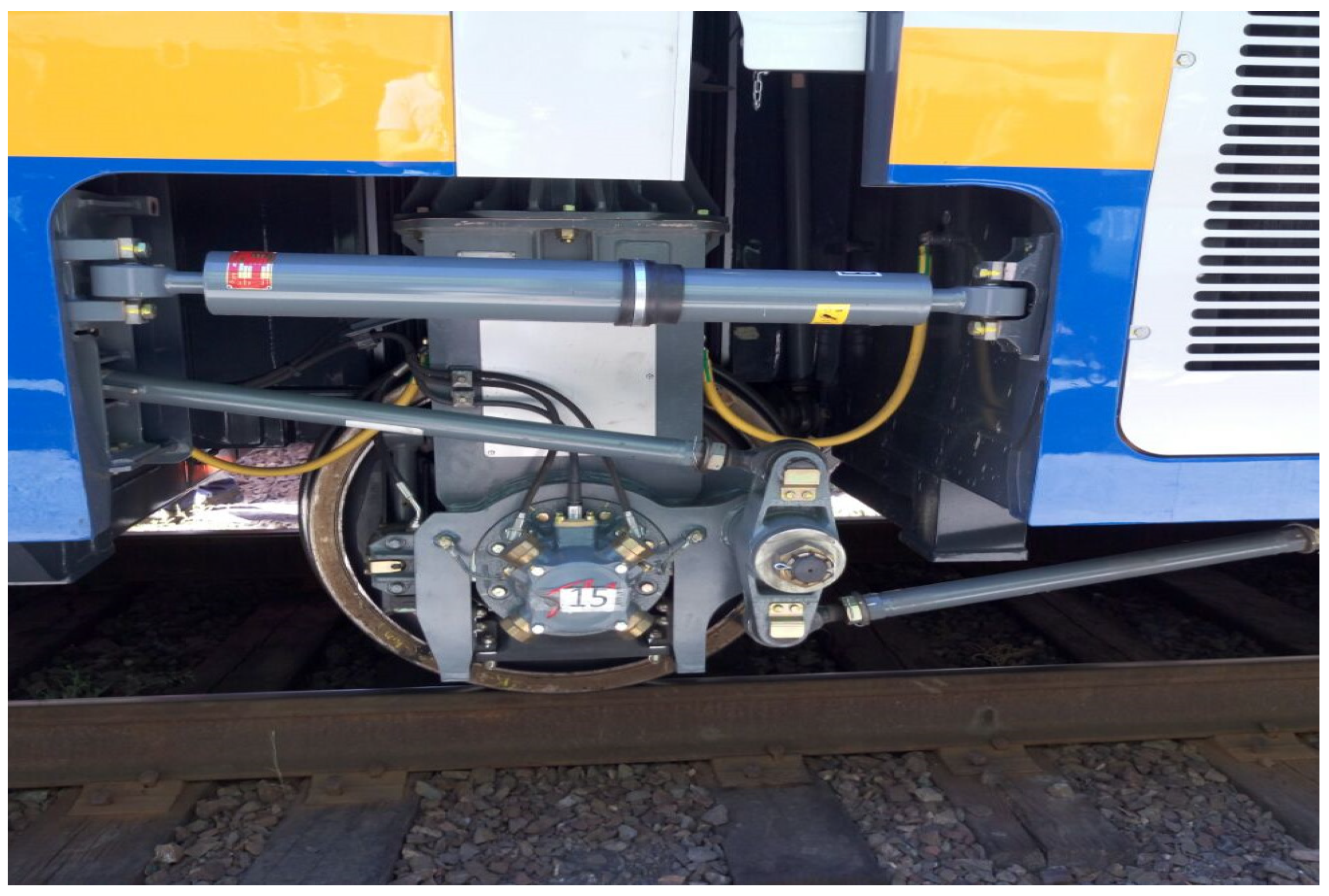
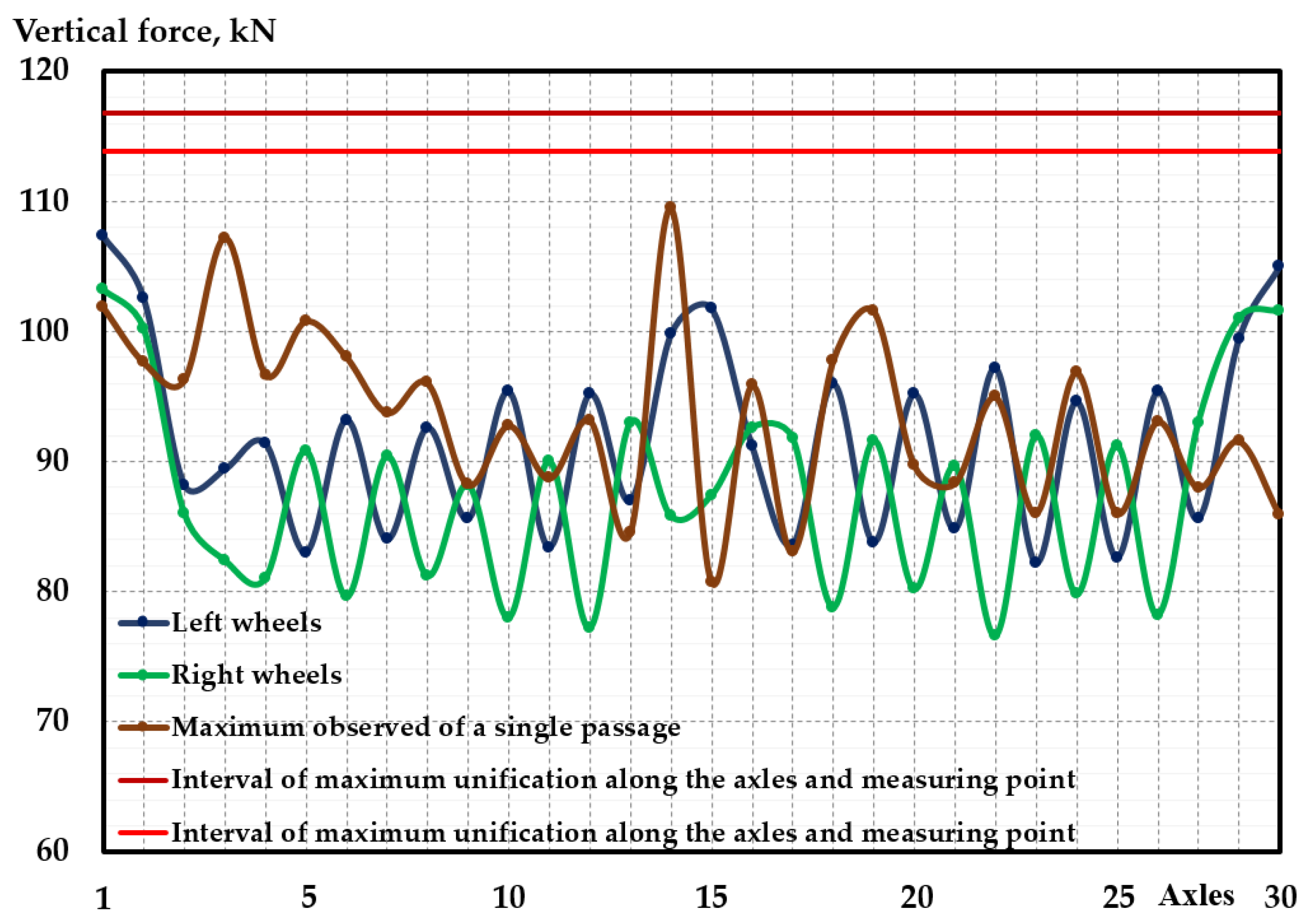
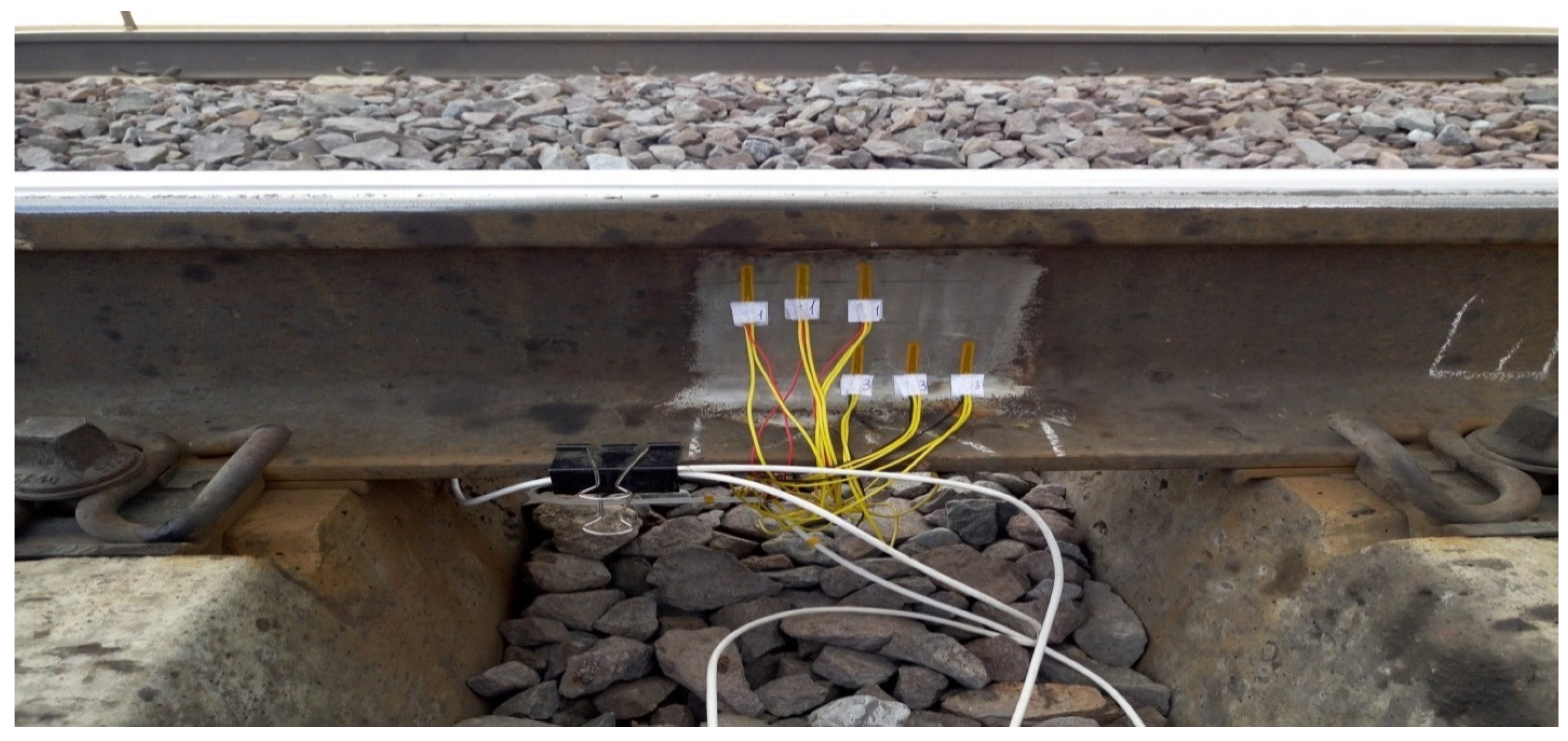
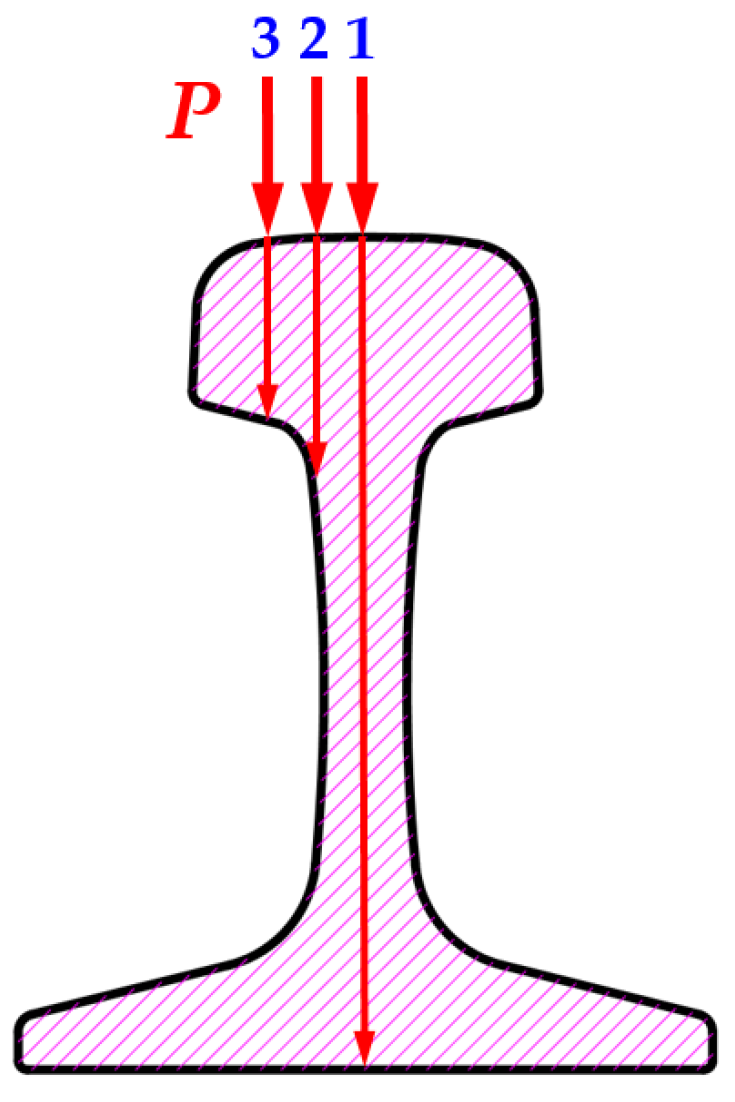
| Type of Wagons | Axle | Axle Weight, kN | Average | Left Wheel, kN | Right Wheel, kN | Difference between Wheels, % |
|---|---|---|---|---|---|---|
| A | 1 | 210.6 | 206.7 | 107.4 | 103.2 | 3.9 |
| 2 | 202.8 | 102.6 | 100.2 | 2.3 | ||
| 30 | 206.6 | 105.0 | 101.6 | 3.2 | ||
| B | 29 | 200.4 | 200.4 | 99.4 | 101.0 | −1.6 |
| C | 3 | 168.8 | 170.3 | 88.2 | 80.6 | 2.5 |
| 4 | 171.8 | 89.4 | 82.4 | 7.8 | ||
| D | 15 | 185.6 | 185.6 | 99.8 | 85.8 | 14.0 |
| E | 16 | 189.2 | 189.2 | 101.8 | 87.4 | 14.1 |
| F | 5 | 172.4 | 174.3 | 91.4 | 81.0 | 11.4 |
| 6 | 173.8 | 83.0 | 90.8 | −9.4 | ||
| 7 | 172.8 | 93.2 | 79.6 | 14.6 | ||
| 8 | 174.4 | 84.0 | 90.4 | −7.6 | ||
| 9 | 173.8 | 92.6 | 81.2 | 12.3 | ||
| 10 | 173.8 | 85.6 | 88.2 | −3.0 | ||
| 11 | 173.4 | 95.4 | 78.0 | 18.2 | ||
| 12 | 173.4 | 83.4 | 90.0 | −7.9 | ||
| 18 | 175.4 | 83.6 | 91.8 | −9.8 | ||
| 19 | 174.8 | 96.0 | 78.8 | 17.9 | ||
| 20 | 175.4 | 83.8 | 91.6 | −9.3 | ||
| 21 | 175.4 | 95.2 | 80.2 | 15.8 | ||
| 22 | 174.4 | 84.8 | 89.6 | −5.7 | ||
| 23 | 173.8 | 97.2 | 76.6 | 21.2 | ||
| 24 | 174.2 | 82.2 | 92.0 | −11.9 | ||
| 25 | 174.4 | 94.6 | 79.8 | 15.6 | ||
| 26 | 173.8 | 82.6 | 91.2 | −10.4 | ||
| 27 | 173.6 | 95.4 | 78.2 | 18.0 | ||
| 28 | 178.6 | 85.6 | 93.0 | −8.6 | ||
| G | 13 | 172.4 | 176.2 | 95.2 | 77.2 | 18.9 |
| 14 | 180.0 | 87.0 | 93.0 | −6.9 | ||
| I | 17 | 183.8 | 183.8 | 91.2 | 92.6 | −1.5 |
| Vertical Wear, mm | Horizontal Wear, mm | Contact Zones, mm | Clearance between Rail and Wheel Flange, mm |
|---|---|---|---|
| 0.1 | – | 20.00 | 0 < δ < 22 |
| 1.7 | – | 49.10 | 0 < δ < 6.5 |
| 2 | – | 51.50 | 0 < δ < 6 |
| 7 | 39.63 | 0 < δ < 17.9 | |
| 15 | 31.58 | 0 < δ < 25.9 | |
| 18 | 28.58 | 0 < δ < 28.9 | |
| 3 | – | 56.55 | 0 < δ < 4.5 |
| 7 | 42.16 | 0 < δ < 18.9 | |
| 15 | 34.17 | 0 < δ < 26.9 | |
| 18 | 31.17 | 0 < δ < 29.9 | |
| 4 | – | 59.94 | 0 < δ < 2.0 |
| 7 | 43.85 | 0 < δ < 18.1 | |
| 15 | 35.86 | 0 < δ < 26.1 | |
| 18 | 32.86 | 0 < δ < 29.1 |
Disclaimer/Publisher’s Note: The statements, opinions and data contained in all publications are solely those of the individual author(s) and contributor(s) and not of MDPI and/or the editor(s). MDPI and/or the editor(s) disclaim responsibility for any injury to people or property resulting from any ideas, methods, instructions or products referred to in the content. |
© 2023 by the authors. Licensee MDPI, Basel, Switzerland. This article is an open access article distributed under the terms and conditions of the Creative Commons Attribution (CC BY) license (https://creativecommons.org/licenses/by/4.0/).
Share and Cite
Bondarenko, I.; Lukoševičius, V.; Keršys, R.; Neduzha, L. Investigation of Dynamic Processes of Rolling Stock–Track Interaction: Experimental Realization. Sustainability 2023, 15, 5356. https://doi.org/10.3390/su15065356
Bondarenko I, Lukoševičius V, Keršys R, Neduzha L. Investigation of Dynamic Processes of Rolling Stock–Track Interaction: Experimental Realization. Sustainability. 2023; 15(6):5356. https://doi.org/10.3390/su15065356
Chicago/Turabian StyleBondarenko, Iryna, Vaidas Lukoševičius, Robertas Keršys, and Larysa Neduzha. 2023. "Investigation of Dynamic Processes of Rolling Stock–Track Interaction: Experimental Realization" Sustainability 15, no. 6: 5356. https://doi.org/10.3390/su15065356






